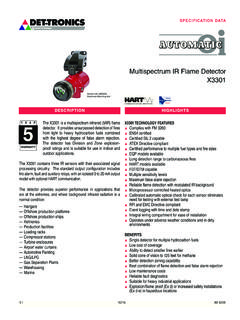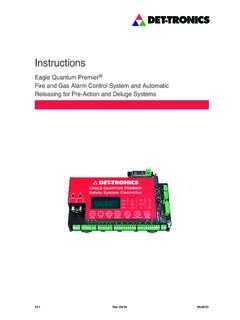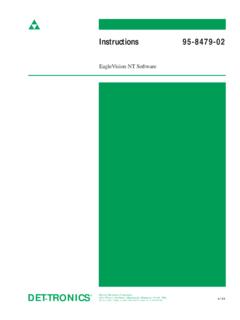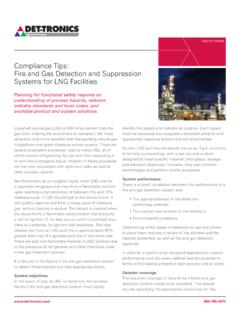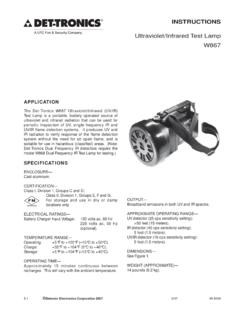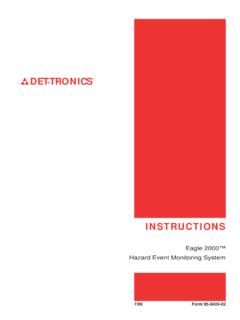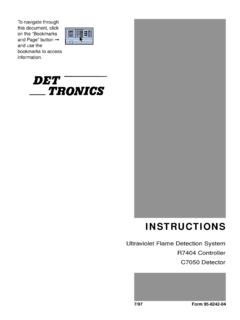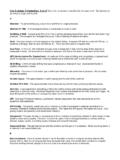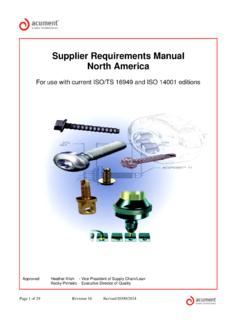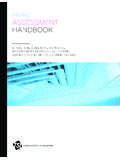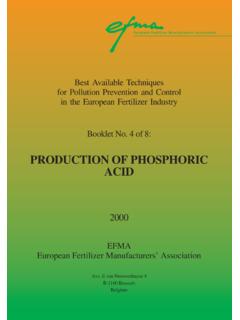Transcription of Table of Contents - Det-Tronics
1 April 2017 Page1 of 24 AIRCRAFT HANGARS, AIRCRAFT MANUFACTURING AND ASSEMBLY FACILITIES, ANDPROTECTION OF AIRCRAFT INTERIORS DURING ASSEMBLYT able of .. Superseded Information .. Hazards .. LOSS PREVENTION .. Introduction to Hangars .. Construction and Location .. General .. Hangars With Fueled Aircraft .. Occupancy .. General .. Protection .. General .. Protection for Hangars With Fueled Aircraft .. Protection for Hangars with Unfueled Aircraft .. Protection for Manufacturing and Assembly Facilities Without Fueled Aircraft .. Protection of Aircraft Interiors During Assembly .. Equipment and Processes .. General .. Paint Spray Operations .. High-Volume, Low-Speed (HVLS) Fans .. Operation and Maintenance .. Housekeeping.
2 Drainage .. Fire Detection and Protection Inspection, Testing, and Maintenance .. Maintenance Hangar Operations .. Training .. Human Factor .. Ignition Source Control .. SUPPORT FOR .. Manufacturing and Assembly Facilities .. Helicopter Hangars .. Fixed Wing Aircraft .. Sprinkler and Foam Water Sprinkler Effectiveness in Hangars .. Zone/System Operation .. NFPA 409 .. Foam Concentrates .. Global .. Others .. 21 APPENDIX A GLOSSARY OF 21 APPENDIX B DOCUMENT REVISION 21 FMGlobalProperty Loss Prevention Data Sheets7-93 2017 Factory Mutual Insurance Company. All rights reserved. No part of this document may be reproduced,storedin a retrieval system, or transmitted, in whole or in part, in any form or by any means, electronic, mechanical,photocopying, recording, or otherwise, without written permission of Factory Mutual Insurance C NFPA 409 AIRCRAFT HANGAR 23 Listof FiguresFig.
3 1. Hangar with large ignitable liquid pool drainage 5 Fig. 2. Hangar where ignitable liquid pool drainage area has been reduced by the use of trench drainage. 6 Fig. 3. Location of hazardous area rated electrical equipment for spraying 13 Fig. 4. Location of hazardous area rated electrical equipment area for 16 Fig. 5. Diagram showing wing span and wing area of an 22 Listof TablesTable 1. Protection Options for Hangars with Fueled 7 Table 2. NFPA Fire Areas for Group II Aircraft 23 Table 3. NFPA Maximum Fire Areas for Group III Aircraft 247-93 Aircraft Hangars, Aircraft Manufacturing andAssemblyFacilitiesPage 2 FMGlobal Property Loss Prevention Data Sheets 2017 Factory Mutual Insurance Company. All rights SCOPEThis loss prevention data sheet provides recommendations for the prevention of and protection against firesandother hazards in occupancies manufacturing, assembling, or storing aircraft, including large fixed-wingaircraft, small fixed-wing aircraft, and helicopters.
4 This data sheet also addresses fire protection of aircraftinteriors during assembly ChangesApril 2017. This document has been completely revised. The following major changes were made:A. Changed the number and title of the data sheet from 7-93N,Aircraft Hangars, to 7-93,Aircraft Hangars,Aircraft Manufacturing and Assembly Facilities, and Protection of Aircraft Interiors During Revised terminology and guidance related to ignitable liquids to provide increased clarity andconsistency. This includes the replacement of references to flammable with ignitable throughout Reorganized the document to provide a format that is consistent with other data Incorporated applicable guidance from OS 7-87,Protection of Aircraft Interiors, and made OS Used a scenario-based approach to determine the hazard and the associated recommended protectionsystem or Added guidance on aircraft manufacturing and assembly facilities and their associated For hangars with fueled aircraft, added guidance on drainage and spacing as this is a key elementin the protection of these hangars and the aircraft.
5 Closely spaced emergency drainage can limit directthermal damage to adjacent Provided guidance on when to treat a hangar as fueled and when to treat it as unfueled for fire Added detailed guidance on foam protection options, detection, and foam reserve supplies for hangarswith fueled Added protection guidance for unfueled hangars and manufacturing and assembly by reference to DataSheet 3-26,Fire Protection Water Demand for Nonstorage Sprinklered Revised the guidance about providing fire-rated walls between different occupancies. Going forward,this will depend on the occupancies Added guidance for the protection of steel Added guidance for safeguards during impairment Superseded InformationThis data sheet supersedes all previous information in Data Sheet 7-93N,Aircraft Hangars, and Data Sheet7-87,Protection of Aircraft HazardsFueled aircraft are routinely brought into storage and maintenance hangars.
6 Fuel capacities of aircraft rangefrom approximately 100 gal (379 L) for small private aircraft to over 60,000 gal (227,125 L) for the largestcommercial aircraft. Even when unfueled (after defueling), the largest commercial aircraft can holdapproximately 300 gal (1,135 L) of residual fuel. Few fires involving spilled fuel have occurred in commercialairline hangars, particularly since kerosene-grade turbine fuels such as Jet A replaced gasoline-grade fuels(Jet B, Avgas, or JP-4). However, Jet A has a high heat release rate comparable to these gasoline-gradefuels. If a hangar lacks adequate protection for the ignitable liquid fuel, an uncontrolled fire could occur,causing damage to the hangar and aircraft hazardous operations conducted within maintenance hangars include fuel transfer, welding, Hangars, Aircraft Manufacturing and AssemblyFacilities7-93FM Global Property Loss Prevention Data SheetsPage3 2017 Factory Mutual Insurance Company.
7 All rights hazard associated with manufacturing and assembly facilities is similar to that for other typicalmanufacturingand assembly facilities, but on a larger scale. These facilities include a wide range ofcommodities and occupancies, such as assembly-related storage, machine shops, electrical componentmanufacturing, clean rooms, computer rooms, ignitable liquid use and storage, and offices and other and manufacturing and assembly facilities are usually tall buildings. When located in regionssubjected to strong winds, the buildings can be susceptible to above-average windstorm loss interiors are constructed almost entirely of combustible components such as insulation, cabin liners,carpets and seats. Although these materials and components are typically subjected to fire hazards testingby aviation regulatory authorities, those tests are not intended to be representative of full-scale aircraftinterior fire hazards.
8 Combustibles such as packaging materials, paints, cleaners, and other ignitable liquidsmay be brought on board the aircraft during maintenance, assembly, and overhaul operations. The interiorareas of the aircraft are shielded from building sprinkler systems, which results in the potential for a largeshielded to the precision nature of aircraft components and the highly regulated industry, components will bemore susceptible to smoke damage than other occupancies. This is dependent on the specific componentsubjected to an event, as well as the exposure or the stage it is at in the assembly process when the LOSS PREVENTION IntroductionUseFM approved equipment, materials, and services whenever they are applicable and available. For alist of products and services that are FM approved, see theApproval Guide, an online resource of Introduction to HangarsIn order to maximize efficient communication of design parameters and objectives, the hangar groupclassification and terminology used within this data sheet is consistent with NFPA 409,Standard on AircraftHangars(2016), a common industry standard.
9 Hangars are classified into four groups: Group I, Group II,Group III and Group IV. See Section and Appendix C for details on this hangar classification Construction and Construct hangars (including doors) and manufacturing and assembly facilities of noncombustibleor FM Approved materials, per Data Sheet 1-1,Fire Safe Building Construction and Do not construct Group IV hangars unless the hangar can meet all the recommendations within thisdata sheet, including those for wind, collapse, and hail Construct permanent and temporary platforms of noncombustible materials. If protection is notprovided under the platform, do not store or stage combustible materials Do not install combustible temporary work surfaces ( , floors, ceiling, walls) inside aircraft interiorsunless:A.
10 Materials are FM A material located on the floor has a maximum flame spread rating of 25 or less per ASTM A material located on the walls has passed a small room test per UL1715 or NFPA Other reputable testing shows that the material will not support a fire in the size and orientation in whichit is to be used ( , bench-scale testing is not sufficient). Design the building to be resistant to natural hazards using guidance from other FM Global data sheetsas Apply guidance from Data Sheet 1-28,Wind Hangars, Aircraft Manufacturing andAssemblyFacilitiesPage 4 FMGlobal Property Loss Prevention Data Sheets 2017 Factory Mutual Insurance Company. All rights Design the building wall cladding and roof using the partially enclosed structural calculation factorswithregard to wind analysis unless a report is provided by a registered professional engineer that indicatesthe doors are designed to be (and can be maintained) sufficiently tight during the design wind speed tosatisfy the requirements in the building code for an enclosed Design the doors to withstand the wind forces referred to in Data Sheet 1-28,Wind Design.
